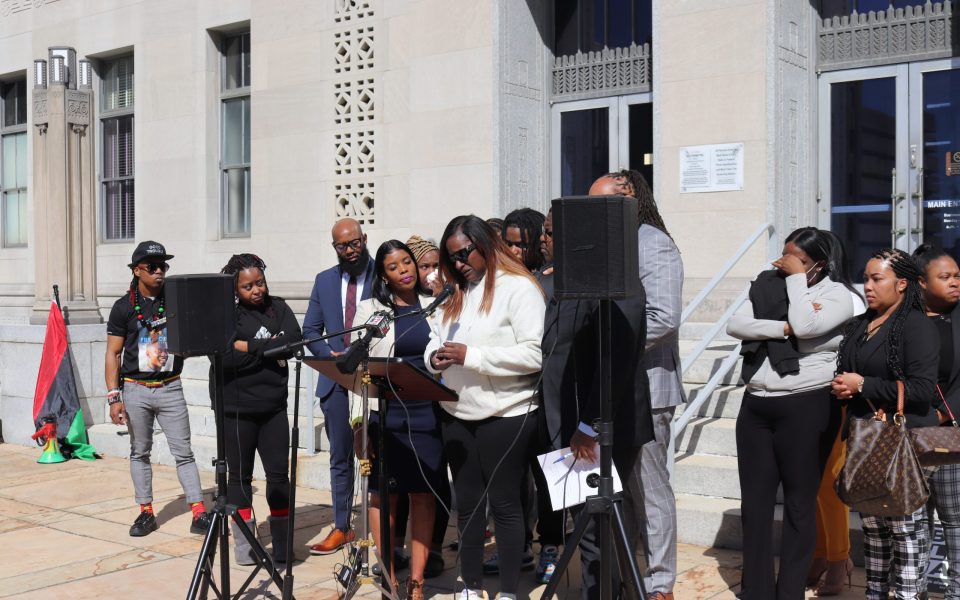Featured photo: Wakita Doriety, mother of Nasanto Antonio Crenshaw, was joined by lawyers Harry Daniels and Chimeaka White to announce a federal lawsuit in the murder of her son by a Greensboro police officer in August 2022. (photo by Gale Melcher)
On Thursday morning, another family gathered in front of the federal courthouse in downtown Greensboro to appeal to the public for justice after a law enforcement officer killed their loved one.
Wakita Doriety, mother of Nasanto Antonio Crenshaw, was joined by lawyers Harry Daniels and Chimeaka White to announce a federal lawsuit in the murder of her son by a Greensboro police officer in August 2022. As reported by TCB in the past, 17-year-old Crenshaw was shot multiple times by a GPD officer during a traffic stop and died on site.
The lawsuit, which was filed in US District Court for the Middle District of North Carolina, alleges that the unnamed Greensboro police officer used unlawful and deadly force against Crenshaw and violated his constitutional rights.
The move comes in the wake of several lawsuits filed in Guilford County in the last few years including in the cases of Marcus Deon Smith, Fred Cox Jr. and Joseph Lopez Jr., all killed by local police.
What does the lawsuit say happened?
According to the lawsuit, the body-cam footage from the night of Aug. 21 shows an unnamed officer, noted as Defendant John Doe in the lawsuit, identifying and pursuing Crenshaw’s vehicle as it drove into the parking lot of Super G Mart off of Market Street.
When Crenshaw’s vehicle came to a stop, the officer exited the patrol vehicle and approached Crenshaw’s car. Shortly afterward, Crenshaw drove off, traveling at a speed of three to five miles per hour, the suit states, and drove a short distance before turning down a dead-end section of the parking lot.
Doe then pursued the vehicle as he noticed that Crenshaw was attempting to make a three-point-turn, to which Doe responded by blocking Crenshaw’s vehicle with his patrol car at a 90-degree angle. At all relevant times, Crenshaw’s hands were visible on the steering wheel to the officer, according to the footage described in the suit.
Attempting to complete the three-point-turn, Crenshaw shifted his vehicle into reverse and began to back into a parking spot, causing the driver’s side of his vehicle to side-swipe the front end of Doe’s patrol car while Doe was still seated inside. As Crenshaw’s vehicle came to a stop, the officer exited his patrol vehicle and commanded Crenshaw: “Get on the ground! Get on the ground! Do it now!”

Crenshaw then turned his wheels to the left as he proceeded out of the parking space, away from the officer and the patrol vehicle. The suit states that at no time was the officer in any imminent threat of harm.
At this point, passengers in the backseat of Crenshaw’s vehicle jumped out, running in the opposite direction of the officer and behind Crenshaw’s car to cross West Market Street.
“As [Crenshaw] was attempting to elude Defendant Doe, Defendant Doe fired his weapon into the front windshield of [Crenshaw’s] moving vehicle,” the suit states. As Crenshaw’s vehicle was passing the officer, two additional shots were fired into the front windshield. After Crenshaw’s vehicle passed Doe, traveling no more than three to five miles per hour, the vehicle jumped a curb and came to a stop. Doe then called in, “Shots fired, shots fired!”
Subsequently, the front-seat passenger exited the vehicle, and was directed by Doe to “get on the ground, do it now!” Crenshaw sustained gunshot wounds to his right forearm, right-side ribcage and to the right side of his neck. He was pronounced dead on site.
“That’s a very different description than the GPD gave y’all…,” said Harry Daniels, one of Doriety’s attorneys. “But that’s what the video shows. It shows the absolutely unjustified killing of Nasanto Crenshaw.”
How has the city responded?
Thus far, the city has released the body-camera footage to the family via a court order but has not released it to the wider public. They have also not released the name of the officer who shot Crenshaw.
“We’ve just gotta go ahead and get the city served,” said attorney Chimeaka White. “More than likely we won’t find out the name of the officer until the discovery phase is open. When that phase opens… we’ll have to amend our complaint to name the officer. So the next step is to start litigating to get justice for the family.”
In a press release published by the police department on Aug. 22, the department stated that “a Greensboro officer conducted a stop of the car Crenshaw was driving for a traffic violation around 9 p.m. in the 4900 block of West Market Street. Shortly after conducting the stop, the officer determined that the car had been stolen.
“As the officer approached the stopped vehicle, the vehicle fled from the traffic stop. The officer attempted to stop the car again and multiple occupants fled from it. While the officer was attempting to detain the vehicle and remaining occupants, the suspect vehicle struck the police car. The vehicle then accelerated, and the officer discharged their weapon. The driver was pronounced deceased at the scene.”
While it’s true that officers often argue that they used deadly force to protect themselves or others, the Greensboro Police Department’s policy manual was updated in 2020 specifically to include how to deal with moving vehicles.
Directive 1.6.4: Use of Deadly Force states that “officers will not fire any weapon from or at a moving vehicle except to counter an imminent threat of death or serious physical injury to the officer or another person and no other means are reasonably available at that time to avoid or eliminate the danger. Officers will consider the following factors in determining whether shooting at a moving vehicle is justified:
- An occupant of the vehicle is using or threatening to use lethal force by means other than the vehicle.
- The vehicle is being operated in a manner deliberately intended to strike a person.
- All other reasonable means of defense or escape (including taking cover or moving out of
- The path of the vehicle or other evasive action) have been exhausted, are not practical, or are not present.
- Use of deadly force must cease after the vehicle no longer presents an immediate threat.”
At the end of the press conference Daniels fielded a question from a reporter about the significance of the vehicle being stolen.
“First of all, it doesn’t matter if it was a stolen car or not,” Daniels said. “Because a stolen car is not a death warrant. It’s a great question but it does not matter…. But let me be very clear, a badge… does not authorize you to be the judge, jury and executioner.”
According to Josie Cambareri, the police department’s public information officer, the State Bureau of Investigation is currently conducting a criminal investigation into the incident. As is departmental policy, the officer in question has been placed on administrative duty.

After the SBI finishes their investigation, they will present their findings to the District Attorney, who in Guilford County is Avery Crump. Then, Crump will have the opportunity to charge the officer or present evidence to a grand jury to indict the officer or not.
While indictments against officers are rare, in June 2022 District Attorney Crump presented evidence in the case against GPD Officer Matthew Hamilton, who shot and killed Joseph Lopez Jr. in November 2021. In June 2022, Hamilton was indicted with the crime of manslaughter. Three days later, the city released body-camera footage from that incident.
Now, the family is seeking “compensatory, economic, consequential and special damages” as well as “punitive damages” against the officer..
“I miss my son, I miss my baby, he was my baby,” Doriety told TCB on Thursday. “I should be able to talk to my son, all I have is pictures and videos. It’s not fair. It’s not fair. I don’t get to hold my son.”
Join the First Amendment Society, a membership that goes directly to funding TCB‘s newsroom.
We believe that reporting can save the world.
The TCB First Amendment Society recognizes the vital role of a free, unfettered press with a bundling of local experiences designed to build community, and unique engagements with our newsroom that will help you understand, and shape, local journalism’s critical role in uplifting the people in our cities.
All revenue goes directly into the newsroom as reporters’ salaries and freelance commissions.


Leave a Reply